QuestionQUESTION: Hi,
I have recently started up 2 tanks - one at my office and one at home. The tank at the office was doing fine with a siamese fighter (male) and about 10 zebras and white minnow mountains, and 3 mollies. Last week, we changed the water and this morning all but the siamese are dead. The tank has an air pump but no filter as we were told it wasn't needed. The heater arrives tomorrow but the temp of the water hasn't been that bad cause the fish tank is under a heater all day and office is all shut up at night. I have just taken half the water out and tested the PH and found it to be too high. I have fixed that, neutralised the water and topped it back up. Now the water is cloudy - any ideas?
Thanks
Tenielle
ANSWER: Hi Tenielle
Before I get into any recommendations, what size tank is it?
Christy
---------- FOLLOW-UP ----------
QUESTION: It's only a reasonably small tank - about 30 litres i think... 46 x 23 x 24cm
ANSWER: Hi Tenielle
Ok, that helps :) I kind of figured being an office fish tank, it was on the smaller side, but just wanted to be sure.
First, that size tank is too small for all those fish. And, aside from the betta(Siamese fighter fish), the other ones really need to have a filtered tank. Bettas are what's called a labrynth fish. They actually take oxygen in from the water surface-from the air, where as other fish take their oxygen in through the water. So, for that reason, bettas can get by with no filter or air stone/air pump in the tank.
BUT, with no filter in the tank to filter out all the nasties in the water, you need to do water changes fairly often. With your size tank, I would be changing out about 50% of the water every 2-3 days. Some sites say you can go longer with a larger tank like that, but I prefer to err on the side of caution. The way I look at it, the fish is living, breathing, eating, and going to the bathroom all in the same water.
If there was a filter on the tank, you could get away with changing out about 20-25% of the water once a week. Like I mentioned already, the other fish need a filter on the tank. A filter or air stone will churn the water surface. This allows the CO2 that the fish put out through their breathing to exchange at the surface with oxygen-which the fish need.
What most likely happened with the other fish, being the tank was overcrowded and there was no filter, the water quality went bad. Fish put out ammonia through their waste and respiration, and from any uneaten food left in the tank. There's a beneficial bacteria that develops, and converts ammonia to a form called nitrites. Ammonia and nitrites are very toxic to fish. Then, the bacteria converts the nitrites to a safer form called nitrates. This process is what's called a cycle process or nitrogen cycle process. Here's a great link with articles with more detailed info on it:
http://freshaquarium.about.com/od/startupcycle/Step_5_The_Cycle.htm
I would say a combination of ammonia and lack of oxygen is what killed off the other fish. That link will be good info for you as well, if you decide to put a filter on the tank. The whole cycle process takes about 4-8 weeks to complete. A tank is completed cycled when there's 0 showing for ammonia and nitrites, and some nitrates are showing.
The heater will be good for the fish, because it will help keep the temperature stable. Frequent or fast temperature fluctuations will stress/kill a fish. Bettas love a temperature about 25-26 C (78-79F). Just be sure to also buy a thermometer so you can monitor the temperatures. With the smaller tanks, they tend to heat up rather quickly, and go over what the heater is set to-especially if there's a light on the tank that puts out heat.
For the ph, unless it's reading over 8.0, I would leave it alone. Most fish we buy now a days are tank bred or farm raised, and they can handle most any ph from 6.0-8.0. When you get into altering the ph, especially with chemicals, there's other factors that need to be addressed-like the water hardness and buffering capacity of the water. If you don't address those as well, the ph will go right back where it was-or worse it'll crash on you. Large fluctuations in ph will also stress/kill the fish. So, it's best to leave it alone. A high or low ph is much better for the fish then one that fluctuates around.
The cloudy water is most likely a bacterial bloom-related to that cycle process I was talking about. Do another large water change, and then get on a schedule like I recommended-once every 2-3 days, change about 50% of the water. Also, if you have gravel on the bottom, I think it would be a good idea to remove most if not all of it. Any uneaten food and the fish waste will accumulate down there, and if you're just changing out the water, that food/waste will produce ammonia in the tank. Or, you could by a small gravel vacuum/syphon to do the water changes with. Just be sure the new water you add is close to the same temperature as the tank water. Also, with just a betta in the tank, you won't need to use the air pump.
Think I got everything covered....If you have any more questions, please ask!! Good luck with your new tanks!
Christy
---------- FOLLOW-UP ----------
QUESTION: ok... thanks for all that!! Phew! think i get it. never knew keeping fish was such a hard job! i think a dog is less work!! :-) Nevermind... I will keep plugging away at it until i get it right.
Ok, the office tank has the siamese, and just 2 balloon mollies and 5 danios in it. Just bought them today... so not sure what i can do with them now...
fish seem happy enough in the tank... pump is bubbling away for the other fish and with the heater tomorrow the siamese will like that. my concern as i said was the cloudiness. I shall continue to change half the water every 2 - 3 days until that clears up and then i might just buy a filter for the tank and that should help with that cleaning problem. there is only about 1/2 inch of gravel on the bottom but i might have to take that out as you said... might see how it looks in a few days. will cut back on feeding them until it looks a bit cleaner.
also, at home, my mollies seem to be sitting on the top of the water a lot... breathing... it's very strange. the ones at work aren't doing that... and yet the tank at home has a filter and pump... any idea why they would be doing that?
AnswerIt's not that bad, once you know what you're doing-and more importantly why you're doing it, it's easy. And, once the filtered tanks finish the cycle process, it's mostly just a matter of doing the weekly water changes. I have 7 tanks and a small pond at home, and it only takes me about an hour to do the weekly maintenance on them.
For your tank at home, check that first link I posted
http://freshaquarium.about.com/od/startupcycle/Step_5_The_Cycle.htm
There's 2 articles on there, ammonia poisoning and nitrite poisoning. Read those, usually when a fish is gasping at the surface or trying to breath at the surface, it usually means one or the other is present in the tank(ammonia or nitrites). While the tank is going through this cycle process, you'll need to do small daily water changes to help dilute those toxins in the water for the fish. Keep that in mind too if you add a filter on your work tank.
For the new fish you bought today....honestly, you'd probably be best off taking them back if you can. Or, buy the filter for that tank, and keep up with the daily water changes until that tank cycles. I wouldn't add anymore fish to that tank either. That's the max I would put in there. And again, with the cloudiness, do a water change as soon as you can, about 50%, then every few days change out 50%. That was all based on it just being a betta in there though...The extra fish will add extra waste/ammonia into the tank. Just keep an eye on them until you decide if you'll get a filter on there.
Christy

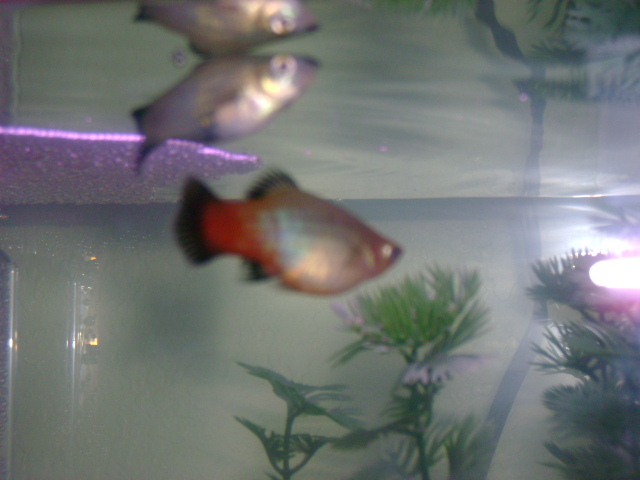 is my fish pregnant and was it labeled correctly in store?
Question
pregnant fish?
I bought a male and 2 females o
is my fish pregnant and was it labeled correctly in store?
Question
pregnant fish?
I bought a male and 2 females o
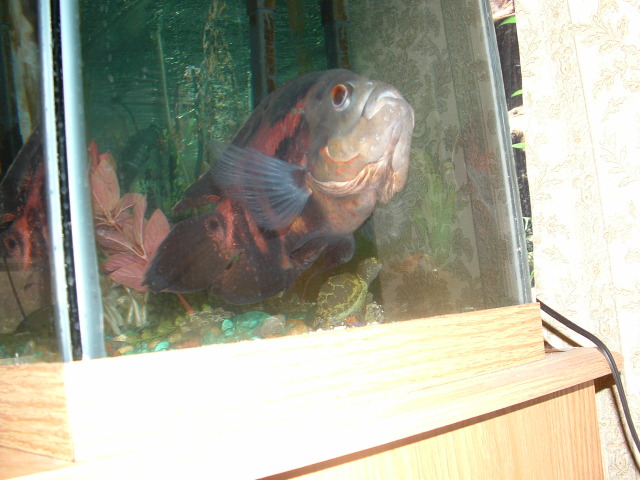 high nitrites Oscar mouth opening and closing
QuestionQUESTION: You have helped me before. I HAVE A 7
high nitrites Oscar mouth opening and closing
QuestionQUESTION: You have helped me before. I HAVE A 7
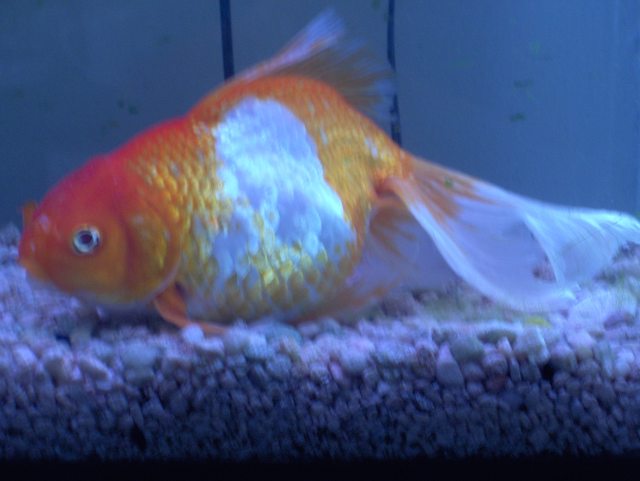 goldfish food
Question
goldie
where can I find a sinking goldfish foo
goldfish food
Question
goldie
where can I find a sinking goldfish foo
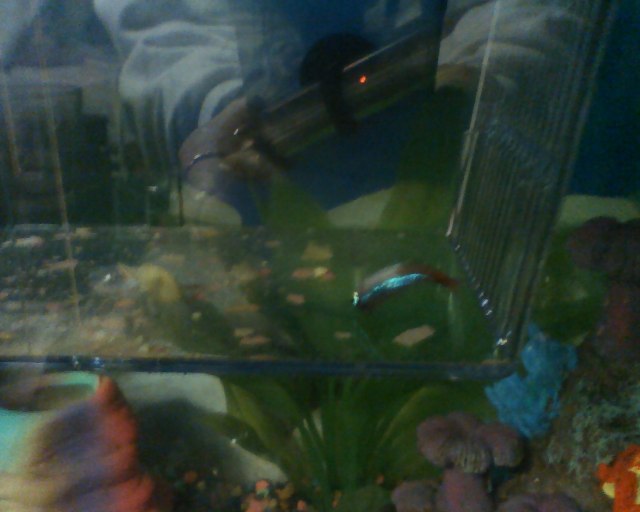 Whats wrong with my fish? Can you please help me?
Question
Neon Tetra tail bent
Hi I was emailing
Whats wrong with my fish? Can you please help me?
Question
Neon Tetra tail bent
Hi I was emailing
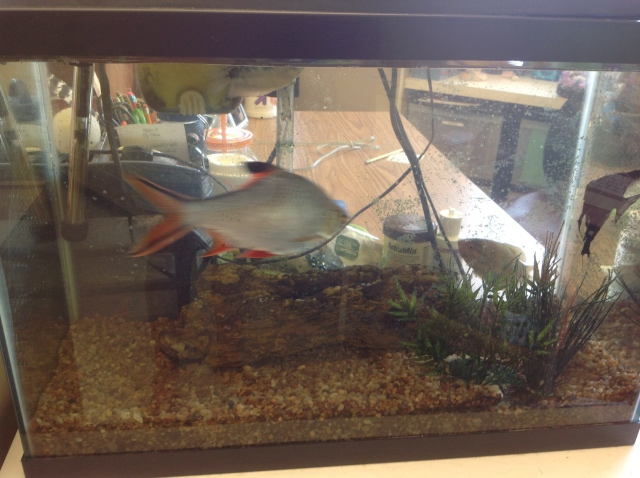 Fresh Water Fish
Question
My Fish Tank
Hi Elizabeth,
I would rea
Fresh Water Fish
Question
My Fish Tank
Hi Elizabeth,
I would rea